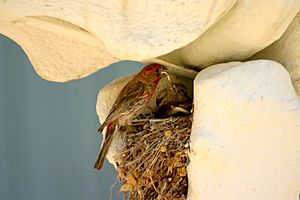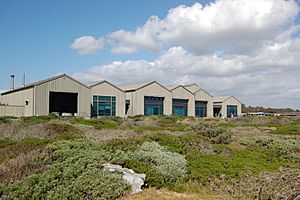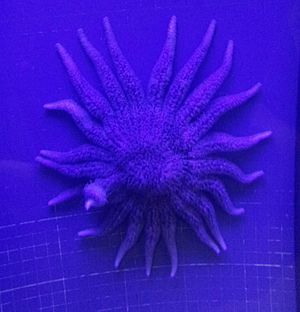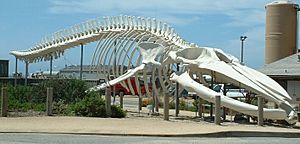Coastal Science Campus facts for kids
The Coastal Science Campus is a special place at the University of California, Santa Cruz (UCSC). It's home to five important groups that study the ocean and coastal environments. These include UCSC's Long Marine Laboratory, the Coastal Biology Building, the NOAA Southwest Fisheries Science Center, the Seymour Marine Discovery Center, and the California Marine Wildlife Veterinary Care and Research Center.
This campus is located at the western edge of Santa Cruz, California. It's about a 10-minute drive from UCSC's main campus. Right next to it is the Younger Lagoon Reserve, a protected natural area. There are walking trails all around the campus that local people use for walking, biking, and watching birds.
Contents
History of the Campus
Building a marine laboratory on land was a big goal for UC Santa Cruz ever since it started in 1965. In 1972, Mrs. Marion Stowell Younger and her husband, Donald, gave 40 acres of land for a marine lab and a natural reserve. This land includes a beautiful, untouched wetland called the Younger Lagoon Reserve. It also has flat areas perfect for building the lab.
The Long Marine Lab part of the campus opened in late 1978. It became the main place for UCSC teachers and students to do ocean research. Later, in 1997, the Marine Wildlife Veterinary Care and Research Center opened. This center is owned by the California Department of Fish and Wildlife. The Seymour Marine Discovery Center, which had been around informally, opened in its permanent building on March 11, 2000. Construction for the Coastal Biology Building and its greenhouses began in May 2015. It was finished and ready for use in September 2017.
What Each Place Does
Joseph M. Long Marine Laboratory
The Joseph M. Long Marine Laboratory is run by UCSC. It's where UCSC's Institute of Marine Sciences is located. This lab mostly focuses on marine sciences. It has the Ocean Health Building, outdoor pools for seals, sea lions, sea otters, and dolphins, and special labs that use seawater. There's also a place for scuba diving, a boatyard, a weather station, and offices for teachers and students.
Coastal Biology Building
The Coastal Biology Building is also managed by UCSC. It supports research and teaching about coastal conservation, how living things interact with their environment (ecology), restoring natural habitats, the effects of climate change, and related rules. Most of UCSC's Ecology and Evolutionary Biology Department is in this building. They do research, train graduate students, teach undergraduate classes, and offer field courses here.
Seymour Marine Discovery Center
The Seymour Marine Discovery Center is connected to UCSC. It's the public part of the Long Marine Lab, where people can learn about the ocean. The Center has a small aquarium and a touch tank area. You can see different local ocean animals there, like swell sharks, sea nettles, cabezon, red octopus, and purple urchins.
Southwest Fisheries Science Center
The Southwest Fisheries Science Center is a research place run by the National Oceanic and Atmospheric Administration (NOAA). Scientists here study and manage fish populations in California. They especially focus on rockfishes and salmon. The Santa Cruz lab is one of several campuses under the SWFSC.
Marine Wildlife Veterinary Care and Research Center
The Marine Wildlife Veterinary Care and Research Center is managed by the California Department of Fish and Wildlife. This center helps rescue and heal marine animals, especially sea otters, that have been affected by oil spills. They also do research on the health of marine wildlife.
Ms. Blue: The Blue Whale Skeleton
"Ms. Blue" is the largest blue whale skeleton displayed anywhere in the world. She is one of only four blue whale skeletons shown in North America. Ms. Blue is 18 feet tall and 87 feet long. She was not fully grown when she washed ashore at Fiddlers Cove near Pescadero on September 6, 1979.
Soon after she was found, biologists and students from UC Santa Cruz started "flensing" her. This means they carefully removed the flesh and blubber from the whale. This whole process took about a month. The skeleton was then moved by helicopter and truck to the marine lab. It stayed in a grassy field for over a year before being buried. Burying the bones allowed nature's tiny helpers, like bacteria, to clean away any remaining tissue and oil.

In the summer of 1985, the bones were dug up, and the work to put the skeleton together began. Frank Perry, a local geologist and museum expert, was hired to clean the bones and prepare them for display. He worked with lab staff and experts from other museums. Together, they built a strong steel frame to hold the bones and create the correct curve of the spine. This big job was finished in 1986.
In 1999, the skeleton was moved and updated. During the first recovery in 1979, some bones were lost to the ocean tides. Others were crushed under the whale's huge weight, or even taken from the beach by people looking for souvenirs. Dr. Dave Casper, a veterinarian from UC Santa Cruz, recreated the 60 missing bones. He made molds from bones borrowed from other places or used similar parts of the existing skeleton. The flipper bones, which were originally placed close to the body, are now shown away from the ribs, as if the whale is swimming.
Natural Bridges State Marine Reserve
The Natural Bridges State Marine Reserve is a special underwater area off the coast near the Long Marine Laboratory. Think of it like an underwater park! This marine protected area helps to protect ocean wildlife and the natural ocean environments.
Desalination Plant
In the late 1970s, Santa Cruz faced a serious drought, meaning there wasn't enough water. Because of this, the Soquel Creek Water District agreed to share the cost with the city of Santa Cruz for a desalination plant. The city had not added to its water supply since that drought. So, a desalination plant would help prevent future water shortages. As of August 2025, work is being done to build a $4 million test desalination facility at the city's Long Marine Lab. This facility will help turn saltwater into fresh drinking water.




